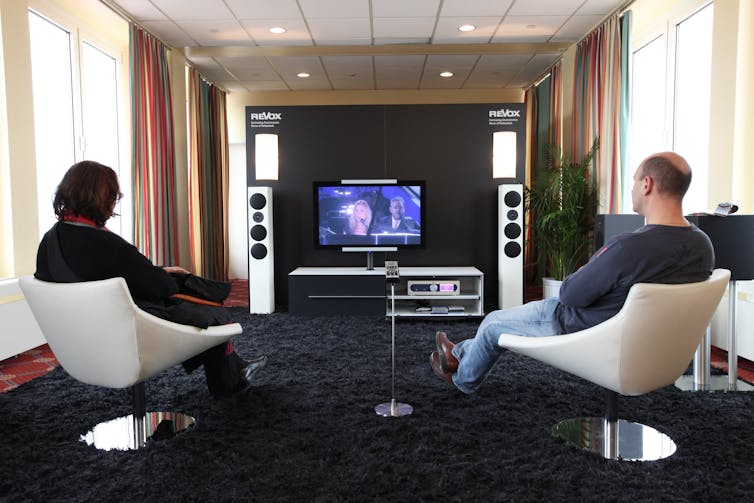
Gregor Gruber
Katie Ellis, Curtin University and Mike Kent, Curtin University
Just over a year ago, on Australia Day 2015, Nine Entertainment Co. and Fairfax media launched Australia’s first video on demand (VoD) service, STAN, as a joint venture. Shortly followed by Presto and the US based Netflix, Australia commenced the subscription video on demand streaming wars.
Attracting audiences matters in the war to dominate the video on demand environment. Niche audiences are particularly important: they add up to a surprisingly large market share, and are ferociously loyal.
In this market, it seems obvious streaming services should compete for the disabled audience, which has typically been neglected as a demographic.
So why do most Australian streaming services not offer basic accessibility features? Should the government force VoD companies to match the accessibility requirements of broadcast television?
TV for the hearing or visually impaired
Television is particularly disabling for people with vision and hearing impairments. These groups may require accessibility options such as closed captions and audio description to engage with television at all.
Captions are well-known and accepted, and have been available on Australian television since 1992. According to a 2012 amendment to the Broadcasting Services Act (BSA) Australian broadcasters must caption 100% of their content between 6am and midnight by 2015. As a result, there’s an expectation that captions should be available on VoD.
By comparison, audio description is largely unknown and isn’t covered by the BSA. Audio description is designed to help blind or visually-impaired people enjoy television, with an extra narration track describing what is happening, usually during pauses in dialogue.
The role of the government
Before the release of VoD in Australia, federal policy papers recognised the need for accessibility features for audiences with vision and hearing impairments. They predicted video on demand companies would include captions and audio description without the need for government intervention.
But a content analysis of the policy sections of STAN, Presto, Netflix, QuickFlix and Foxtel on Demand in November last year found none of the Australian video on demand providers have an accessibility policy.
STAN quietly introduced closed captions for around 300 titles early this year, with more to come. Presto is “working on” adding captions, and Quickflix has adopted a distributor-led approach, making captions available if the distributing studio offered them.
Despite the lack of clear accessibility policy, Netflix is in front in terms of accessibility, with captions available for most content. Audio descriptions for some content became available in April 2015, shortly after the company’s Australian launch.
Chris Mikul, who is Media Access Australia’s project manager for television, and author of the 2015 Access on Demand report, told us this was due to the impacts of legislation in the US, namely the Communications and Video Accessibility Act.
Mikul believes the complete lack of audio description from local streaming services can be attributed to the lack of legislation requiring it.
Advocating for accessibility
For companies that operate internationally, legislation in a single country can prompt improvements across their entire network. Audio description services from Netflix is one example of this; overall legislation is extremely effective at improving disability access.
When Netflix became available in Australia and New Zealand last year, the head of The Accessible Netflix Project, Robert Kingett, argued the move could see improved Netflix accessibility internationally due to the history of accessibility advocacy in Australia.
Following Bruce Maguire v The Sydney Olympics Organising Committee, Australia was the first country to introduce online accessibility legislation.
Despite the Australian policy predictions laid out in 2008, a European study of 31 countries found digital and online television accessibility was more widely available in countries where legislation is in place.
But despite successful trials, there is no legislation in place regarding the provision of audio description in Australia and the other VoD providers have not introduced audio description as a way to compete with Netflix.
Kingett told us in an interview that VoD providers treat accessibility as an “afterthought,” particularly for blind people, who most don’t think of as watching TV.
Yet research dating back to the 1990s shows almost 100% people with vision impairments watch television at least once a day. Kingett describes the lack of accessibility as evidence VoD is “stuck in the dark ages” and recommends streaming services hire people with disabilities:
If companies want to learn about accessibility, or have someone who will really care so they don’t have to, then actually go out and hire a disabled department leader to lead the audio description team, accessibility design team, or otherwise.
Our research shows people with disabilities, including people with vision impairments do use VoD and continue to have particular unmet access needs.
As the Netflix example illustrates, both legislation and recognition of people with disabilities as a key audience demographic will result in a more accessible television environment for people with disabilities.![]()
Katie Ellis, Senior Research Fellow in Internet studies, Curtin University and Mike Kent, Senior lecturer in Internet Studies , Curtin University
This article is republished from The Conversation under a Creative Commons license. Read the original article.